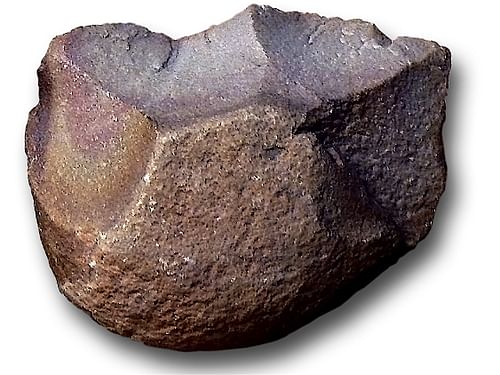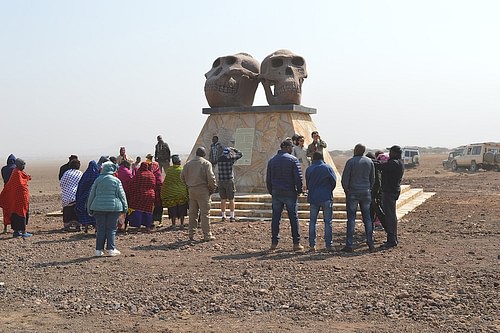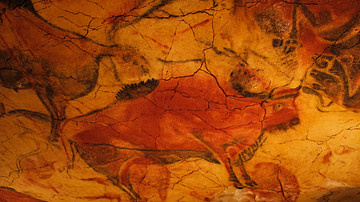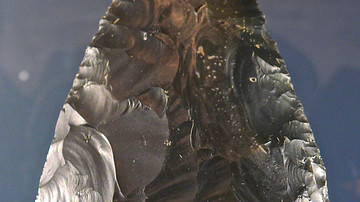
The appearance of simple stone tools, widely known as Oldowan tools or the Oldowan industry, marked the beginning of our technological revolution. To our knowledge, these artifacts appeared around 2.6 million years ago in the savannahs of Eastern Africa. Today, the Oldowan is still the earliest, universally acknowledged stone tool industry. Simple flaked tools like choppers, scrapers, or rudimentary cutting instruments are typical for this archaic style of manufacturing. While crude from today's perspective, these tools gave a tremendous evolutional advantage to our ancestors. They gave us access to new sources of food and allowed us to process other raw materials, such as wood and bone. Consequently, over a period of roughly 900,000 years, the Oldowan shaped the technological landscape in Africa, South Asia, the Middle East, and Europe. The more advanced Acheulean industry (famous for the oval and bifacial shaped hand-axes) then replaced the Oldowan around 1.76 million years ago.
What Does Oldowan mean?
The Oldowan industry's name stems from Olduvai Gorge in Tanzania, which is a 50 km-long rift full of significant paleoanthropological findings. It was here that the couple Mary and Louis Leakey discovered various artifacts and prehistoric fossils during their excavations. They coined the term Oldowan and later published their findings in several books. Today Olduvai Gorge is a UNESCO World Heritage site. If you find yourself on the way to the Serengeti National Park, consider a detour to visit the museum explaining the locations' contributions to understanding human prehistory. On the way, you will be greeted by the Olduvai Gorge Monument, which consists of two huge model skulls of species discovered at the excavation site.
Where & When Were Oldowan Tools Used?
Despite being among the most famous sites, Olduvai Gorge is not home to the oldest Oldowan tools. This honor belongs to the Gona river system in Ethiopia, which contained stone artifacts up to 2.6 million years old. However, there is increasing speculation about the existence of even older stone tools.
In 2015 CE, French archaeologist Sonia Harmand and her colleagues published a paper about their findings near Lake Turkana in Kenya. They describe crude, archaic stone tools with an estimated age of 3.3 million years that would predate the oldest Oldowan tools from the Gona river system by 700,000 years! Named Lomekwian tools after their site of discovery, Lomekwi 3, this industry appears even more simplistic than the Oldowan. Together with findings of scratch marks on 3.3 million-year-old animal bones in Ethiopia, the Lomekwi tools gave evidence for older stone instruments than the Oldowan.
Or did they? Both findings were evaluated critically by the scientific community. Counterarguments include the possibility of natural causes or an inaccurate dating method for the Lomekwian tools. Until the dismissal of these counterarguments, the Oldowan remains the oldest stone tool industry. Multiple sites around the world show the spread of Oldowan artifacts, although minor details in the production methodology vary.
Most places of discovery are located in Africa, especially the eastern part of the continent. Apart from Tanzania and Ethiopia, paleoanthropologists have found Oldowan tools in Kenya and Chad, to name a few. In the north of Africa, Algeria and Egypt brought forth the most discoveries. On the continental area of Eurasia, the most famous Oldowan site is Dmansi in Georgia. At the turn of the millennium, scientists discovered early human fossils alongside hundreds of Oldowan tools and animal bones. The importance of these findings can not be stressed enough, as Dmansi, alongside Shengchen in China, is the earliest known evidence of human presence outside of Africa. Further excavation sites are known in Spain, France, Pakistan, Syria, Iran, and Israel.
How Were Oldowan Tools made?
The makers of Oldowan tools employed least-effort flaking strategies. At the heart of their technique lay fissile rocks, like volcanic stones and quartzites. These so-called "cores" were rested upon a stable surface and struck with a hammerstone. Using the right impact and angle will produce a thin, sharp stone flake. Some Oldowan tools show signs of further retouches, like an extra sharpening or bifacially shaped cores. The latter is of particular interest, as these tools mark the transition to the more advanced Acheulean industry. Some publications use the term "Developed Oldowan" for these reshaped tools.
How were Oldowan Tools Used?
Various suggestions exist about the classification of Oldowan tool types. The most famous classification groups the tools by their supposed usage and was created by Mary Leakey. There are heavy-duty tools with a dimension of more than five centimeters. Typical examples are choppers made from battered, edged cores and heavy-duty scrapers. Most likely those Oldowan tools served as primitive cutting instruments and our ancestors might have used them to scavenge meat, cut plants, or conduct basic woodworking. Examples of light-duty tools (less than five centimeters in dimension) are scrapers and awls, which might have come in handy for more delicate work, like boring or working hides.
Additionally, the following three categories exist:
- Utilized artifacts, like anvils and hammerstones. Our ancestors might have used the latter to crush nuts and bones
- Fragments and flakes that show no further sign of usage and are most likely waste (debitage)
- Unmodified stones found outside their usual, geological locations (manuports)
This categorization is still the most popular one today, yet there is no unchallenged and standardized way of organizing Oldowan tools. Other approaches focus on the form of the tools or the techniques used.
Who Made the Oldowan Tools?
The debate about who exactly the toolmakers were can become fervent, as no one knows for sure who invented the first stone tools. Paleoanthropologists have to gather clues like detectives to identify the most likely suspects. For this task, they can rely on three lines of evidence:
- Fossils found alongside the artifacts
- Zoological studies by observing modern apes
- Theories about hominin (the term used for humans and our closest relatives) evolution
The Oldowan industry is about 2.6 million years old. In the beginning, Homo habilis, the first archaic human, was thought to be the inventor. However, with today's knowledge, the oldest Oldowan tools are known to predate the earliest Homo habilis fossils.
The genus Homo exhibits bigger brains, increased brain-to-body ratio, as well as smaller jaws and teeth. If you rely less on your physique to chew food, alternative tools are needed, especially since the brain is hungry for nutrients. Modern human brains consume about 20 % of the body's energy while being only about 2% of the body's total weight. Behavioral and dietary changes due to tool usage most likely contributed to the development of Homo habilis, indicating that the manufacturers of the earliest Oldowan tools still belonged to the australopithecines. These are close, now extinct relatives to humans.
Anatomical variations existed between australopithecine species as well. The more robust forms (sometimes referred to as Paranthropus) were vegetarians with big cheeks and teeth, while the gracile forms had smaller relative teeth and jaws. In modern research, the lines have blurred and some specimens show robust and gracile characteristics.
Various theories exist on tool invention by australopithecines. On the one hand, robust specimens like Australopithecus (Paranthropus) aethiopicus seem plausible inventors. Despite their strong jaws and teeth, a vegetarian diet would have benefitted from tools to cut plants. On the other hand, gracile australopithecines needed to compensate for their relatively smaller jaws and teeth. The invention of Oldowan tools might have occurred from a need to access new sources of food.

What about other apes? Modern apes use sticks and stones as tools, so maybe their ancestors were able to shape the Oldowan tools? This theory is unlikely, although not impossible: Experiments with bonobos have shown they can create stone tools if taught. But so far, no ape has been observed achieving this in the wild. Additionally, the Oldowan tools show a higher level of craftsmanship than ape-made artifacts.
Long story short: It is impossible to tell, which species created the first Oldowan tools, and future discoveries will hopefully shine further light on this question.
Were Other Tools Used Next to the Oldowan?
But what about other natural resources? Unfortunately, materials like bone, hide, or wood are less resilient than stone. While our ancestors may have used them, tools made from these substances have not survived. The Oldowan tools remain at the moment the first documented step in our technological journey.
The next step followed approximately 700,000 years later. Around 1.76 million years ago, the transition to the more advanced Acheulean industry happened. Mostly associated with remains of Homo erectus, these stone tools exhibit more deliberate and delicate post-processing. Most likely, not only hammerstones played a role in the manufacture of Acheulean tools, but also other materials, such as bone or antlers. These developments would have been impossible if the Oldowan industry had not laid the foundation for the production of stone tools.










